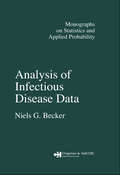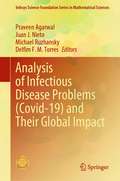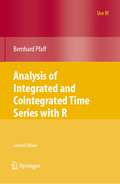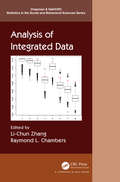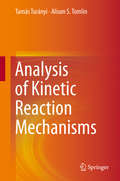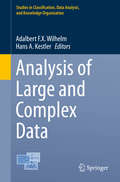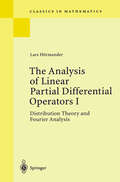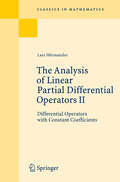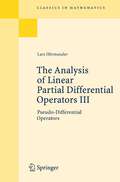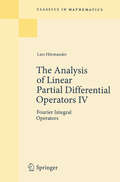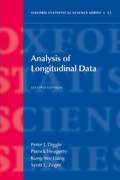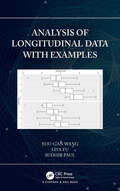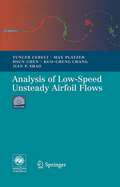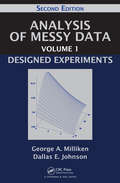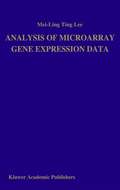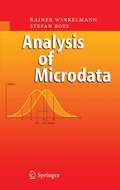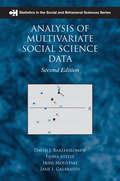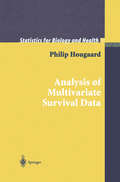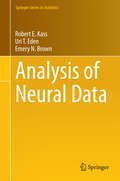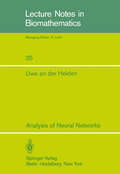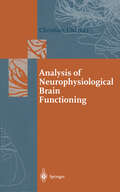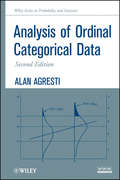- Table View
- List View
Analysis of Infectious Disease Data
by N.G. BeckerThe book gives an up-to-date account of various approaches availablefor the analysis of infectious disease data. Most of the methods havebeen developed only recently, and for those based on particularlymodern mathematics, details of the computation are carefullyillustrated. Interpretation is discussed at some length and the emphasisthroughout is on making statistical inferences about epidemiologicallyimportant parameters.Niels G. Becker is Reader in Statistics at La Trobe University,Australia.
Analysis of Infectious Disease Problems (Infosys Science Foundation Series)
by Praveen Agarwal Juan J. Nieto Michael Ruzhansky Delfim F. M. TorresThis edited volume is a collection of selected research articles discussing the analysis of infectious diseases by using mathematical modelling in recent times. Divided into two parts, the book gives a general and country-wise analysis of Covid-19. Analytical and numerical techniques for virus models are presented along with the application of mathematical modelling in the analysis of their spreading rates and treatments. The book also includes applications of fractional differential equations as well as ordinary, partial and integrodifferential equations with optimization methods. Probability distribution and their bio-mathematical applications have also been studied. This book is a valuable resource for researchers, scholars, biomathematicians and medical experts.
Analysis of Integrated and Cointegrated Time Series with R (Use R!)
by Bernhard PfaffThis book is designed for self study. The reader can apply the theoretical concepts directly within R by following the examples.
Analysis of Integrated Data (Chapman & Hall/CRC Statistics in the Social and Behavioral Sciences)
by Li-Chun Zhang and Raymond L. ChambersThe advent of "Big Data" has brought with it a rapid diversification of data sources, requiring analysis that accounts for the fact that these data have often been generated and recorded for different reasons. Data integration involves combining data residing in different sources to enable statistical inference, or to generate new statistical data for purposes that cannot be served by each source on its own. This can yield significant gains for scientific as well as commercial investigations. However, valid analysis of such data should allow for the additional uncertainty due to entity ambiguity, whenever it is not possible to state with certainty that the integrated source is the target population of interest. Analysis of Integrated Data aims to provide a solid theoretical basis for this statistical analysis in three generic settings of entity ambiguity: statistical analysis of linked datasets that may contain linkage errors; datasets created by a data fusion process, where joint statistical information is simulated using the information in marginal data from non-overlapping sources; and estimation of target population size when target units are either partially or erroneously covered in each source. Covers a range of topics under an overarching perspective of data integration. Focuses on statistical uncertainty and inference issues arising from entity ambiguity. Features state of the art methods for analysis of integrated data. Identifies the important themes that will define future research and teaching in the statistical analysis of integrated data. Analysis of Integrated Data is aimed primarily at researchers and methodologists interested in statistical methods for data from multiple sources, with a focus on data analysts in the social sciences, and in the public and private sectors.
Analysis of Integrated Data (Chapman & Hall/CRC Statistics in the Social and Behavioral Sciences)
by Li-Chun Zhang Raymond L. ChambersThe advent of "Big Data" has brought with it a rapid diversification of data sources, requiring analysis that accounts for the fact that these data have often been generated and recorded for different reasons. Data integration involves combining data residing in different sources to enable statistical inference, or to generate new statistical data for purposes that cannot be served by each source on its own. This can yield significant gains for scientific as well as commercial investigations. However, valid analysis of such data should allow for the additional uncertainty due to entity ambiguity, whenever it is not possible to state with certainty that the integrated source is the target population of interest. Analysis of Integrated Data aims to provide a solid theoretical basis for this statistical analysis in three generic settings of entity ambiguity: statistical analysis of linked datasets that may contain linkage errors; datasets created by a data fusion process, where joint statistical information is simulated using the information in marginal data from non-overlapping sources; and estimation of target population size when target units are either partially or erroneously covered in each source. Covers a range of topics under an overarching perspective of data integration. Focuses on statistical uncertainty and inference issues arising from entity ambiguity. Features state of the art methods for analysis of integrated data. Identifies the important themes that will define future research and teaching in the statistical analysis of integrated data. Analysis of Integrated Data is aimed primarily at researchers and methodologists interested in statistical methods for data from multiple sources, with a focus on data analysts in the social sciences, and in the public and private sectors.
Analysis of Kinetic Reaction Mechanisms
by Tamás Turányi Alison S. TomlinChemical processes in many fields of science and technology, including combustion, atmospheric chemistry, environmental modelling, process engineering, and systems biology, can be described by detailed reaction mechanisms consisting of numerous reaction steps. This book describes methods for the analysis of reaction mechanisms that are applicable in all these fields. Topics addressed include: how sensitivity and uncertainty analyses allow the calculation of the overall uncertainty of simulation results and the identification of the most important input parameters, the ways in which mechanisms can be reduced without losing important kinetic and dynamic detail, and the application of reduced models for more accurate engineering optimizations. This monograph is invaluable for researchers and engineers dealing with detailed reaction mechanisms, but is also useful for graduate students of related courses in chemistry, mechanical engineering, energy and environmental science and biology.
Analysis of Large and Complex Data (Studies in Classification, Data Analysis, and Knowledge Organization #0)
by Adalbert F.X. Wilhelm Hans A. KestlerThis book offers a snapshot of the state-of-the-art in classification at the interface between statistics, computer science and application fields. The contributions span a broad spectrum, from theoretical developments to practical applications; they all share a strong computational component. The topics addressed are from the following fields: Statistics and Data Analysis; Machine Learning and Knowledge Discovery; Data Analysis in Marketing; Data Analysis in Finance and Economics; Data Analysis in Medicine and the Life Sciences; Data Analysis in the Social, Behavioural, and Health Care Sciences; Data Analysis in Interdisciplinary Domains; Classification and Subject Indexing in Library and Information Science. The book presents selected papers from the Second European Conference on Data Analysis, held at Jacobs University Bremen in July 2014. This conference unites diverse researchers in the pursuit of a common topic, creating truly unique synergies in the process.
The Analysis of Linear Partial Differential Operators I: Distribution Theory and Fourier Analysis (Classics in Mathematics)
by Lars HörmanderThe main change in this edition is the inclusion of exercises with answers and hints. This is meant to emphasize that this volume has been written as a general course in modern analysis on a graduate student level and not only as the beginning of a specialized course in partial differen tial equations. In particular, it could also serve as an introduction to harmonic analysis. Exercises are given primarily to the sections of gen eral interest; there are none to the last two chapters. Most of the exercises are just routine problems meant to give some familiarity with standard use of the tools introduced in the text. Others are extensions of the theory presented there. As a rule rather complete though brief solutions are then given in the answers and hints. To a large extent the exercises have been taken over from courses or examinations given by Anders Melin or myself at the University of Lund. I am grateful to Anders Melin for letting me use the problems originating from him and for numerous valuable comments on this collection. As in the revised printing of Volume II, a number of minor flaws have also been corrected in this edition. Many of these have been called to my attention by the Russian translators of the first edition, and I wish to thank them for our excellent collaboration.
The Analysis of Linear Partial Differential Operators II: Differential Operators with Constant Coefficients (Classics In Mathematics Ser.)
by Lars HörmanderAuthor received the 1962 Fields Medal Author received the 1988 Wolf Prize (honoring achievemnets of a lifetime) Author is leading expert in partial differential equations
The Analysis of Linear Partial Differential Operators III: Pseudo-Differential Operators (Classics In Mathematics Ser.)
by Lars HörmanderFrom the reviews: "Volumes III and IV complete L. Hörmander's treatise on linear partial differential equations. They constitute the most complete and up-to-date account of this subject, by the author who has dominated it and made the most significant contributions in the last decades.....It is a superb book, which must be present in every mathematical library, and an indispensable tool for all - young and old - interested in the theory of partial differential operators." L. Boutet de Monvel in Bulletin of the American Mathematical Society, 1987. "This treatise is outstanding in every respect and must be counted among the great books in mathematics. It is certainly no easy reading (...) but a careful study is extremely rewarding for its wealth of ideas and techniques and the beauty of presentation." J. Brüning in Zentralblatt MATH, 1987.
The Analysis of Linear Partial Differential Operators IV: Fourier Integral Operators (Classics in Mathematics)
by Lars HörmanderFrom the reviews: "Volumes III and IV complete L. Hörmander's treatise on linear partial differential equations. They constitute the most complete and up-to-date account of this subject, by the author who has dominated it and made the most significant contributions in the last decades.....It is a superb book, which must be present in every mathematical library, and an indispensable tool for all - young and old - interested in the theory of partial differential operators." L. Boutet de Monvel in Bulletin of the American Mathematical Society, 1987 "This treatise is outstanding in every respect and must be counted among the great books in mathematics. It is certainly no easy reading (...) but a careful study is extremely rewarding for its wealth of ideas and techniques and the beauty of presentation." J. Brüning in Zentralblatt MATH, 1987 Honours awarded to Lars Hörmander: Fields Medal 1962, Speaker at International Congress 1970, Wolf Prize 1988, AMS Steele Prize 2006
Analysis of Longitudinal Data (Oxford Statistical Science Series #25)
by Peter Diggle Patrick Heagerty Kung-Yee Liang Scott ZegerThe first edition of Analysis for Longitudinal Data has become a classic. Describing the statistical models and methods for the analysis of longitudinal data, it covers both the underlying statistical theory of each method, and its application to a range of examples from the agricultural and biomedical sciences. The main topics discussed are design issues, exploratory methods of analysis, linear models for continuous data, general linear models for discrete data, and models and methods for handling data and missing values. Under each heading, worked examples are presented in parallel with the methodological development, and sufficient detail is given to enable the reader to reproduce the author's results using the data-sets as an appendix. This second edition, published for the first time in paperback, provides a thorough and expanded revision of this important text. It includes two new chapters; the first discusses fully parametric models for discrete repeated measures data, and the second explores statistical models for time-dependent predictors.
Analysis of Longitudinal Data (Oxford Statistical Science Ser. #25)
by Peter J. DiggleThe first edition of Analysis for Longitudinal Data has become a classic. Describing the statistical models and methods for the analysis of longitudinal data, it covers both the underlying statistical theory of each method, and its application to a range of examples from the agricultural and biomedical sciences. The main topics discussed are design issues, exploratory methods of analysis, linear models for continuous data, general linear models for discrete data, and models and methods for handling data and missing values. Under each heading, worked examples are presented in parallel with the methodological development, and sufficient detail is given to enable the reader to reproduce the author's results using the data-sets as an appendix. This second edition, published for the first time in paperback, provides a thorough and expanded revision of this important text. It includes two new chapters; the first discusses fully parametric models for discrete repeated measures data, and the second explores statistical models for time-dependent predictors.
Analysis of Longitudinal Data with Example
by You-Gan Wang Liya Fu Sudhir PaulDevelopment in methodology on longitudinal data is fast. Currently, there are a lack of intermediate /advanced level textbooks which introduce students and practicing statisticians to the updated methods on correlated data inference. This book will present a discussion of the modern approaches to inference, including the links between the theories of estimators and various types of efficient statistical models including likelihood-based approaches. The theory will be supported with practical examples of R-codes and R-packages applied to interesting case-studies from a number of different areas. Key Features: •Includes the most up-to-date methods •Use simple examples to demonstrate complex methods •Uses real data from a number of areas •Examples utilize R code
Analysis of Longitudinal Data with Example
by You-Gan Wang Liya Fu Sudhir PaulDevelopment in methodology on longitudinal data is fast. Currently, there are a lack of intermediate /advanced level textbooks which introduce students and practicing statisticians to the updated methods on correlated data inference. This book will present a discussion of the modern approaches to inference, including the links between the theories of estimators and various types of efficient statistical models including likelihood-based approaches. The theory will be supported with practical examples of R-codes and R-packages applied to interesting case-studies from a number of different areas. Key Features: •Includes the most up-to-date methods •Use simple examples to demonstrate complex methods •Uses real data from a number of areas •Examples utilize R code
Analysis of Low-Speed Unsteady Airfoil Flows
by Tuncer Cebeci Max Platzer Hsun Chen Kuo-cheng Chang Jian P. ShaoThe standard textbooks on aerodynamics usually omit any discussion of un steady aerodynamics or, at most, consider it only in a single chapter, based on two justifications. The first is that unsteady aerodynamics should be regarded as a specialized subject required "only" in connection with understanding and an alyzing aeroelastic phenomena such as flutter and gust response, and therefore should be dealt with in related specialist books. The second reason appears to be reluctance to discuss aerodynamics with the inclusion of the time-dependent terms in the conservation equations and the boundary conditions for fear that added complications may discourage the reader. We take the opposite view in this book and argue that a full understanding of the physics of lift generation is possible only by considering the unsteady aerody namics of the starting vortex generation process. Furthermore, certain "steady" flows are inherently unsteady in the presence of flow separation, as for example the unsteady flow caused by the Karman vortex shedding downstream of a cylin der and "static" airfoil stall which is an inherently unsteady flow phenomenon. Therefore, it stands to reason that a unified treatment of aerodynamics that yields steady-state aerodynamics as a special case offers advantages. This rea soning is strengthened by the developments in computational fluid dynamics over the past forty years, which showed that accurate steady-state solutions can be obtained efficiently by solving the unsteady flow equations.
Analysis of Messy Data Volume 1: Designed Experiments, Second Edition
by George A. Milliken Dallas E. JohnsonA bestseller for nearly 25 years, Analysis of Messy Data, Volume 1: Designed Experiments helps applied statisticians and researchers analyze the kinds of data sets encountered in the real world. Written by two long-time researchers and professors, this second edition has been fully updated to reflect the many developments that have occurred since t
Analysis of Microarray Gene Expression Data (Trends In Logic Ser.)
by Mei-Ling Ting LeeAfter genomic sequencing, microarray technology has emerged as a widely used platform for genomic studies in the life sciences. Microarray technology provides a systematic way to survey DNA and RNA variation. With the abundance of data produced from microarray studies, however, the ultimate impact of the studies on biology will depend heavily on data mining and statistical analysis. The contribution of this book is to provide readers with an integrated presentation of various topics on analyzing microarray data.
Analysis of Microdata
by Rainer Winkelmann Stefan BoesThe availability of microdata has increased rapidly over the last decades, and standard statistical and econometric software packages for data analysis include ever more sophisticated modeling options. The goal of this book is to familiarize readers with a wide range of commonly used models, and thereby to enable them to become critical consumers of current empirical research, and to conduct their own empirical analyses. The focus of the book is on regression-type models in the context of large cross-section samples. In microdata applications, dependent variables often are qualitative and discrete, while in other cases, the sample is not randomly drawn from the population of interest and the dependent variable is censored or truncated. Hence, models and methods are required that go beyond the standard linear regression model and ordinary least squares. Maximum li- lihood estimation of conditional probability models and marginal probability e?ects are introduced here as the unifying principle for modeling, estimating and interpreting microdata relationships. We consider the limitation to m- imum likelihood sensible, from a pedagogical point of view if the book is to be used in a semester-long advanced undergraduate or graduate course, and from a practical point of view because maximum likelihood estimation is used in the overwhelming majority of current microdata research. In order to introduce and explain the models and methods, we refer to a number of illustrative applications. The main examples include the deter- nants of individual fertility, the intergenerational transmission of secondary schoolchoices,andthewageelasticityoffemalelaborsupply.
Analysis of Multivariate Social Science Data (Chapman And Hall/crc Statistics In The Social And Behavioral Sciences Ser.)
by David J. Bartholomew Fiona Steele Jane Galbraith Irini MoustakiDrawing on the authors' varied experiences working and teaching in the field, Analysis of Multivariate Social Science Data, Second Editionenables a basic understanding of how to use key multivariate methods in the social sciences. With updates in every chapter, this edition expands its topics to include regression analysis, con
Analysis of Multivariate Survival Data (Statistics for Biology and Health)
by Philip HougaardSurvival data or more general time-to-event data occur in many areas, including medicine, biology, engineering, economics, and demography, but previously standard methods have requested that all time variables are univariate and independent. This book extends the field by allowing for multivariate times. As the field is rather new, the concepts and the possible types of data are described in detail. Four different approaches to the analysis of such data are presented from an applied point of view.
Analysis of Neural Data (Springer Series in Statistics)
by Robert E. Kass Uri T. Eden Emery N. BrownContinual improvements in data collection and processing have had a huge impact on brain research, producing data sets that are often large and complicated. By emphasizing a few fundamental principles, and a handful of ubiquitous techniques, Analysis of Neural Data provides a unified treatment of analytical methods that have become essential for contemporary researchers. Throughout the book ideas are illustrated with more than 100 examples drawn from the literature, ranging from electrophysiology, to neuroimaging, to behavior. By demonstrating the commonality among various statistical approaches the authors provide the crucial tools for gaining knowledge from diverse types of data. Aimed at experimentalists with only high-school level mathematics, as well as computationally-oriented neuroscientists who have limited familiarity with statistics, Analysis of Neural Data serves as both a self-contained introduction and a reference work.
Analysis of Neural Networks (Lecture Notes in Biomathematics #35)
by U. an HeidenThe purpose of this work is a unified and general treatment of activity in neural networks from a mathematical pOint of view. Possible applications of the theory presented are indica ted throughout the text. However, they are not explored in de tail for two reasons : first, the universal character of n- ral activity in nearly all animals requires some type of a general approach~ secondly, the mathematical perspicuity would suffer if too many experimental details and empirical peculiarities were interspersed among the mathematical investigation. A guide to many applications is supplied by the references concerning a variety of specific issues. Of course the theory does not aim at covering all individual problems. Moreover there are other approaches to neural network theory (see e.g. Poggio-Torre, 1978) based on the different lev els at which the nervous system may be viewed. The theory is a deterministic one reflecting the average be havior of neurons or neuron pools. In this respect the essay is written in the spirit of the work of Cowan, Feldman, and Wilson (see sect. 2.2). The networks are described by systems of nonlinear integral equations. Therefore the paper can also be read as a course in nonlinear system theory. The interpretation of the elements as neurons is not a necessary one. However, for vividness the mathematical results are often expressed in neurophysiological terms, such as excitation, inhibition, membrane potentials, and impulse frequencies. The nonlinearities are essential constituents of the theory.
Analysis of Neurophysiological Brain Functioning (Springer Series in Synergetics)
by Christian UhlThe analysis of neurophysiological brain function is a highly interdisciplinary field of research. In addition to the traditional areas of psychology and neurobiology, various other scientific disciplines, such as physics, mathematics, computer science, and engineering, are involved. The book reviews a wide spectrum of model-based analyses of neurophysiological brain function. In the first part, physical and physiological models and synergetic concepts are presented. The second part focuses on analysis methods and their applications to EEG/MEG data sets. It reviews methods of source localization, the investigation of synchronization processes, and spatio-temporal modeling based on dynamical systems theory. The book includes contributions by well-known scientists such as Hermann Haken, Scott Kelso and Paul Nunez, among others. It is written for students and scientists from all the above-mentioned fields.
Analysis of Ordinal Categorical Data (Wiley Series in Probability and Statistics #656)
by Alan AgrestiStatistical science’s first coordinated manual of methods for analyzing ordered categorical data, now fully revised and updated, continues to present applications and case studies in fields as diverse as sociology, public health, ecology, marketing, and pharmacy. Analysis of Ordinal Categorical Data, Second Edition provides an introduction to basic descriptive and inferential methods for categorical data, giving thorough coverage of new developments and recent methods. Special emphasis is placed on interpretation and application of methods including an integrated comparison of the available strategies for analyzing ordinal data. Practitioners of statistics in government, industry (particularly pharmaceutical), and academia will want this new edition.
